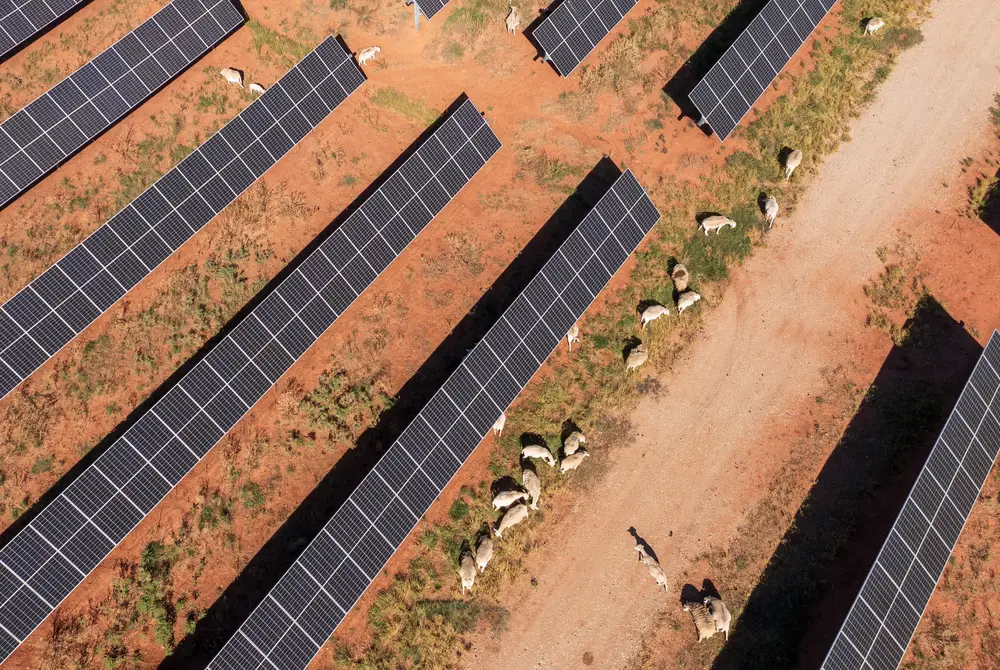Sheep Graze on Texas Solar Farms as Renewable Energy Companies Embrace Agriculture
time:2023-11-07 10:25:03 Views:0 author:Jinan Freakin Power Ltd.
The practice of using land for both agriculture and solar power generation, known as agrivoltaics, is becoming increasingly common in Texas and nationwide.
HASKELL COUNTY — Landon Terry steered the utility vehicle down the solar farm’s dirt road. The glittering panels were tilted almost vertically, blocking his view of the horizon. But the cowboy-turned-farmer knew he was close to his target when he saw fresh poop on the road. “I have to holler,” Terry, 44, said as he parked the vehicle and hopped out.
“Woo—ooh!” Terry shouted. His voice rang through the sunny morning. Terry waited. Along with his hard hat and protective sunglasses, he wore a button-down shirt, jeans and a silver belt buckle decorated with his cattle brand.
Then came the response.
“Baa.”
“Now we know where to go,” Terry said.
Terry jumped back into the Polaris Ranger and drove until he saw some of the 277 sheep in the pasture. A beige and black mixture of breeds such as Dorper, Katahdin and St. Croix, the sheep graze on native grasses, filling their bellies and keeping the vegetation low so it doesn’t shade the solar panels.

The practice of using land for both agriculture and solar power generation, known as agrivoltaics, is becoming increasingly common in Texas and nationwide. It can mean growing flowers for butterflies and bees, planting food crops around the solar panels or raising sheep for meat. Experimenting with agrivoltaics took off as the number of industrial-scale solar farms skyrocketed in recent years in Texas. The state produces more solar power than any other except California. And although the panels emit no pollution, they are often built on former agricultural land, which can create friction in ranching and farming communities. Agrivoltaics could help solar companies win over opponents who want to see the land’s former use maintained. The sheep burp methane, a greenhouse gas, but they don’t pollute like a diesel mower, can be more economical and are able to reach the hard-to-get spots around poles and wires without causing damage.
The marriage of renewable energy and agriculture is also creating jobs for people such as Terry, who cares for the sheep on about a third of this 1,800-acre solar farm when he’s not farming cotton. Terry grew up on a nearby cattle ranch where his dad worked. As a kid, Terry raised his own animals too, learning to spot a sick one’s runny nose or eyes. He jokes that he’s been riding horses since he was in his mother’s womb. Before the company Enel North America started to build the solar farm in 2020 in Haskell County — a rural area with an estimated 5,400 residents between Dallas-Fort Worth and Lubbock — Terry said he used to work cattle on that same land. “We’re not losing anything,” Terry says. “We’re just doing it differently.”
People began to explore in earnest how to blend solar power generation and agriculture 12 to 15 years ago as solar technology became less expensive, said Jordan Macknick, lead energy-water-land analyst for the National Renewable Energy Laboratory. Interest in agrivoltaics ticked up as developers built more solar farms, he said.
Generally, solar companies lease land for a few decades. They need between five and 10 acres to generate one megawatt of power, according to an industry group. That’s enough to power about 200 Texas homes during periods of high demand.
“Every single square inch of land is owned by, cherished, protected by someone,” Macknick said. “People want to find a way in which we can make good use of the land.”
Macknick’s group at the federal research agency has mapped 383 sites in the country where solar companies added an agricultural use. Some states offer financial incentives for agrivoltaic projects or give them priority to connect to the grid, Macknick said. Texas electricity regulators don’t.
In an interview, Texas Agriculture Commissioner Sid Miller said he would like to see solar companies mount their panels high enough so cattle could graze under them or machinery could be used to plant crops like wheat and hay. The state has lost more than 2 million acres of agricultural land over the last 25 years, he said.
Farm land attracts solar developers because it tends to be flat, sunny and clear, said Samantha Levy, conservation and climate policy manager for the American Farmland Trust, which aims to conserve farmland. If a solar project is built on farmland, the Trust advocates for building it in a way that allows the land to go back into agricultural production later, or to stay in production after solar panels are installed.




